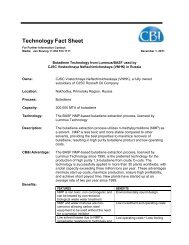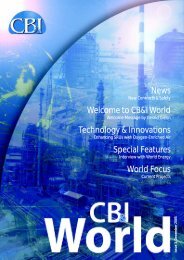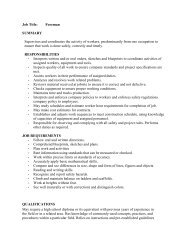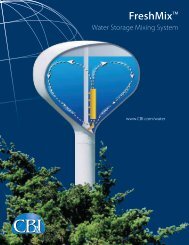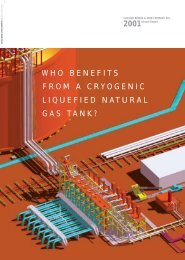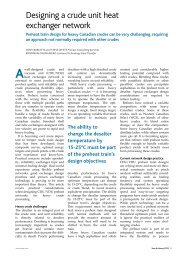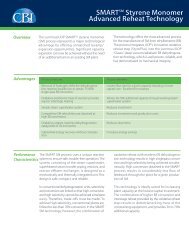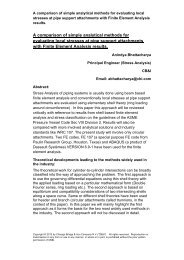Dimethyl Carbonate - CB&I
Dimethyl Carbonate - CB&I
Dimethyl Carbonate - CB&I
You also want an ePaper? Increase the reach of your titles
YUMPU automatically turns print PDFs into web optimized ePapers that Google loves.
<strong>Dimethyl</strong> <strong>Carbonate</strong><br />
Overview<br />
Lummus Technology offers the Polimeri/Lummus<br />
process for the production of dimethyl carbonate<br />
(DMC), a non-toxic intermediate used in the production<br />
of polycarbonates, lubricants, solvents, and other<br />
products, including pharmaceutical applications.<br />
DMC is also used directly as a solvent or a gasoline/diesel<br />
fuel additive. The Polimeri/Lummus DMC process is<br />
a unique, non-phosgene route using CO, methanol<br />
and O 2 to produce DMC, CO 2 and water. It avoids<br />
the safety and waste product issues associated with<br />
conventional phosgene-based DMC processes.<br />
The CO 2 can be sent to a CO generation unit and<br />
recycled back to the process. This environmentally<br />
safe process produces high purity product and can<br />
be applied to large capacity plants. Since Lummus<br />
also offers the Polimeri/Lummus diphenyl carbonate<br />
(DPC) process, there are opportunities for<br />
energy integration as well when both DMC and<br />
DPC are produced.<br />
Advantages<br />
Process Features<br />
Oxidative carbonylation of methanol<br />
Green process<br />
One step reaction<br />
In situ continuous catalyst regeneration<br />
Proven at high capacity (up to 50 kta<br />
per train)<br />
Process Benefits<br />
Large availability of raw materials • CO 2 is the only by-product,<br />
which can be converted to CO and recycled within the process<br />
Does not use phosgene • Environmentally safe • No dangerous<br />
intermediates or by-products • Extensive heat integration<br />
Catalyst is re-oxidized in a one-stage single CSTR reactor using O 2 ,<br />
which is an inexpensive oxidant • Less process complexity • Low<br />
investment<br />
Normal operation requires no make-up catalyst<br />
Economies of scale<br />
Performance<br />
Characteristics<br />
Typical Overall Material Balance<br />
Typical DMC Product Quality<br />
Feeds<br />
MT/MT DMC Product<br />
Purity<br />
99.8 wt.% min<br />
Methanol (100% basis) 0.768<br />
Color APHA<br />
10 max.<br />
CO (100% basis) 0.519<br />
Acidity (as H x CO 3 )<br />
Chlorine (organics cmpd)<br />
50 ppm wt max.<br />
100 ppm wt max.<br />
O 2 (100% basis) 0.296<br />
Methanol<br />
100 ppm wt max.<br />
HCl (30 wt% solution) 0.023<br />
Water<br />
100 ppm wt max.<br />
Main Products<br />
<strong>Dimethyl</strong> <strong>Carbonate</strong> 1.000<br />
CO 2 to CO unit 0.301
<strong>Dimethyl</strong> <strong>Carbonate</strong><br />
Block Flow<br />
Diagram<br />
Acid/Catalyst Recycle<br />
Azeotrope Recycle<br />
CH 3<br />
OH<br />
CO<br />
O 2<br />
Reaction<br />
Acid<br />
Recovery<br />
Azeotropic<br />
Distillation<br />
DMC<br />
Purification<br />
<strong>Dimethyl</strong><br />
<strong>Carbonate</strong><br />
Product<br />
HCI<br />
CO Recycle<br />
Water<br />
Organics<br />
Removal<br />
CO<br />
Recovery<br />
CO 2<br />
to CO Unit<br />
Process<br />
Description<br />
Methanol, CO and O 2 react in the presence of a<br />
copper-containing catalyst to yield DMC and water.<br />
The main by-product is CO 2 , with minor amounts<br />
of organics like dimethyl ether and methyl chloride.<br />
A small quantity of HCl is fed to the reactor to<br />
maintain catalyst activity.<br />
Unreacted gases, saturated with organics, are fed<br />
to the organics removal section. The clean gases –<br />
composed of CO, CO 2 and inerts – are subsequently<br />
fed to the CO recovery unit where CO is recycled<br />
back to the reaction section and CO 2 is sent to an<br />
OSBL CO generation unit.<br />
The reaction section effluent, containing unreacted<br />
methanol, DMC, water, and traces of catalyst and<br />
HCl, is sent to the acid recovery section where<br />
catalyst and HCl are separated and recycled back<br />
to the reaction section. The remaining effluent is fed<br />
to the azeotropic distillation section. Methanol/DMC<br />
azeotrope is recycled back to the reaction section<br />
and DMC with water are fed to the final purification<br />
section to obtain DMC product.<br />
Process<br />
Chemistry<br />
2 CH<br />
3<br />
OH + CO<br />
Methanol Carbon<br />
Monoxide<br />
+<br />
1/2 O 2<br />
Oxygen<br />
(CH 3<br />
O) 2<br />
C=O<br />
<strong>Dimethyl</strong><br />
<strong>Carbonate</strong><br />
+<br />
H 2<br />
O<br />
Water<br />
www.CBI.com/lummus-technology<br />
Only employees, agents, or representatives authorized under and pursuant to written agreement<br />
with CB&I are authorized to distribute this brochure to an actual or potential client of CB&I.<br />
©Copyright 2012 by Chicago Bridge & Iron Company. All rights reserved.



